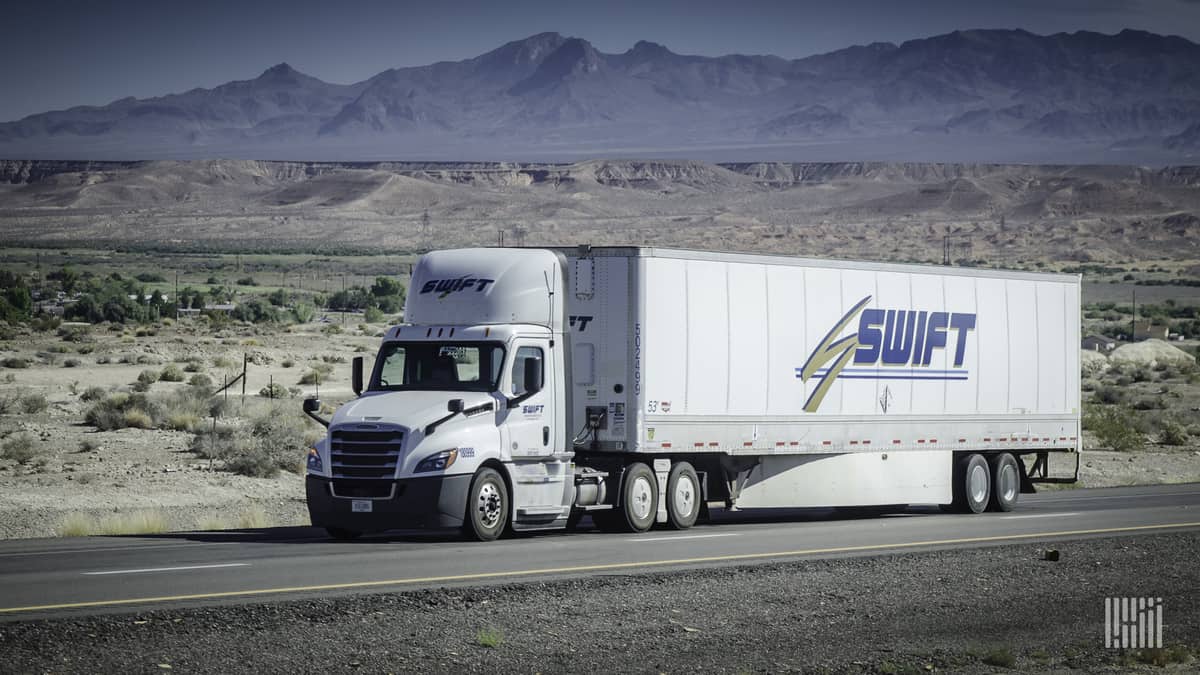Sagging sentiment for truckload stocks was on display Wednesday as the earnings beat at the nation’s largest carrier, Knight-Swift Transportation (NYSE: KNX), proved too little for investors. Even though the company capitalized on strong fundamentals in the quarter to post results well ahead of the 2019 fourth quarter, the stock gapped 7% lower by midday.
The Phoenix-based company reported adjusted earnings per share of 94 cents, only slightly ahead of the 91-cent consensus estimate, but significantly outpacing 55 cents from a year ago. The company confirmed 2021 adjusted EPS guidance of $3.20 to $3.40, which is in line with consensus of $3.36.
TL stocks have backed up from September highs as analysts turned the page to the new year and to hopes of a more pronounced recovery in the industrial economy favoring less-than-truckload and railroad stocks. Also, many investors have concerns that the heady days of high demand and soaring spot rates are drawing to a close and that the recent spike in truck orders will spoil the current tight capacity backdrop sooner than later.
The rest of the TL stocks were down low- to mid-single-digit percentages midday with the 2021 favorites, the LTLs, off by a similar amount. The S&P 500 was off more than 2%.
In a Wednesday note to clients, Deutsche Bank (NYSE: DB) securities analyst Amit Mehrotra said the result was “about as solid as one can expect” and proves that “earnings power is increasing cycle-over-cycle,” which “speaks to how the intrinsic value of the company is evolving, irrespective of positioning.”
On the downward move in the TL stocks, “Maybe the right answer is intrinsic value doesn’t matter, and it’s all about sentiment, positioning and rate of change in spot rates. But we’re still optimistic that underlying earnings power over cycles is what is most important for the mid/long-term outlook of equities,” Mehrotra said.

TL ramps to sub-80% OR
Knight-Swift’s TL segment rode soaring demand for anything consumer-related in the quarter. Revenue was up 9% year-over-year, excluding fuel surcharges, as loaded miles per tractor dipped 3% and rate per loaded mile jumped 14% to $2.64. The result was an 11% increase in revenue per tractor in the quarter.
Management’s 2021 guidance calls for low-double-digit percentage increases in contract rates.
The tightness in the driver labor pool didn’t materially impact the carrier’s ability to seat tractors. Average tractors in use declined only 1% year-over-year with the count actually improving by a couple of units sequentially. However, the TL price improvement was shared with drivers as management noted an increase in “driver-related expenses” in the press release.
Salaries, wages and benefits expense as a percentage of revenue was 60 basis points higher in the quarter. The company noted, “The challenge of sourcing and retaining drivers will continue and lead to additional driver wage inflation.”
The result was an adjusted operating ratio of 79.3%, 690 basis points better year-over-year. The legacy Swift fleet operated at a 74.1% adjusted OR with the Knight fleet posting a 78.9% mark. Both fleets were just north of 80% for the full year, operating within 80 bps of each other, a far cry from two years ago when the Swift segment operated 700 bps behind Knight.
Adjusted operating income in the segment was up 64% year-over-year to $195 million.

Brokerage and intermodal making a comeback
The brokerage segment posted revenue growth of 35% year-over-year, with gross margins improving 90 bps to 16.4%, a notable improvement from 11% in the third quarter. The company likely sacrificed load count, down 9%, to capture higher rates. Revenue per load increased 51% to $2,155.
Knight-Swift rolled out its digital brokerage platform, Select, in the first half of 2020. In the fourth quarter, Select digitally matched more than 5,000 carriers with loads, representing 20% of total brokered loads.
Intermodal saw steady top-line results, with loads and revenue per load improving modestly. Load growth of less than 1% lagged results reported by the U.S. Class I railroads, which saw an 11% year-over-year increase in intermodal traffic during the quarter, according to the Association of American Railroads. The intermodal OR improved 470 bps to 94.8%.
“We continue to work on initiatives to support our business, develop our network, and improve our cost structure within the Intermodal segment, and we expect to continue to see improved results in 2021,” the press release stated.

Share repurchases headline fourth-quarter cash deployment
Knight-Swift ended the fourth quarter with $739 million of available liquidity, including $157 million in unrestricted cash, and net debt of $758 million. The company repurchased $180 million in stock during 2020, $145 million of which was repurchased in the fourth quarter. The share buyback authorization was reset to $250 million as the company had completed nearly 80% of its prior authorization.
The carrier generated $920 million in cash flows from operations and free cash flow of $532 million during 2020, which included a $93 million settlement relating to an independent contractor classification lawsuit. The company expects net capital expenditures to range from $450 million to $500 million in 2021, up from net capex of $388 million last year.
“We continue to manage our leverage ratio relative to our targeted range and remain committed to a strong capital structure, which we believe will position us for long-term success and enable us to pursue further opportunities for organic growth, growth through acquisitions, and other capital allocation opportunities,” the release concluded.











